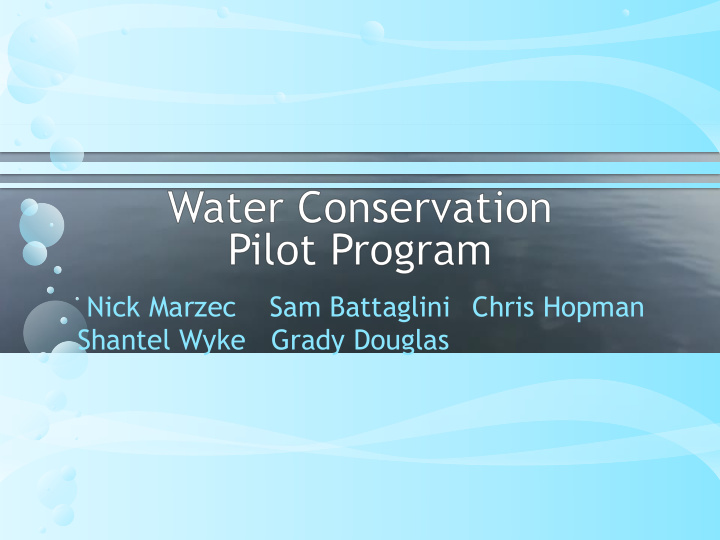



Nick Marzec Sam Battaglini Chris Hopman Shantel Wyke Grady Douglas
What is the Problem? • Significant population growth
Community Partners • Mark Holmes − Water Resources Manager • Katie Wilken − Planning Manager • Who are we trying to incentivize? • What is our objective? • Where have similar problems been solved?
Objective • Reduce or eliminate outdoor water use − Target commercial, residential development totallandscapecare.com swamplot.com inhabitat.com motherearthnews.com
Progression • Started with group interest − Water conservation is a pressing issue • Initial thoughts and ideas − Goodyear has a lot of potential • Provided solutions − Voluntary incentive-based pilot program • Discussing program with Mark • Preliminary research − existing incentive-based programs? − Goodyear’s master plan? − collaboration with other teams
Data Gathering • Finding program which give specific cost reductions − CA, AZ, WA and other states • Psychological research − How will groups respond to particular incentives? • Specific new development in Goodyear − Voluntary incentive- based pilot program
Stakeholders • City of Goodyear − What is the city’s master plan? − How do we align the program with the city’s vision? − How can we avoid mandatory curtailment? • No agricultural water control − State controlled irrigation districts • Home-builders and developers − Focus on new development
Incentives • To mutually benefit 2 or more parties • How can incentives be effective? − Oberlin College • How might incentives fail? − Beloit Corporation • Why might they fail? • How can this affect Goodyear?
Incentives How they do and don’t work • Pay is not a motivator • Rewards punish • Rewards ignore reasons • Rewards discourage risk taking • Rewards rupture relationships • Rewards undermine interest
Program Basis • Thus, we seek to create an incentive program where − Developers have freedom in conservation methods − Developers are eager to join − Holds businesses to Goodyear’s guidelines and standards − Preserves the importance of water conservation
Lessons Learned • Goodyear is a large city − Vast undeveloped regions − Large planned development zones • Legislation changes are difficult − Adapting to change may take time • Many local counties and cities share Goodyear’s goals − Curbing water use − Maintaining existing supply
Program Structure • The team selected a point-based system − Includes a certification hierarchy • Inspired by numerous existing systems • Flexible and dynamic for developers − Adjustable scale − Expandable actions list − Variable incentives
Program Structure
Why Points • Numerous organizations, cities, and states use this concept • LEED:
Why Points? BuiltGreen WA EarthAdvantage Portland Vermont BuiltGreen Green Built Home (WEI) Grand Rapids HBA Hudson Valley HBA Built Green Colorado San Jose CALgreen Coconino County NC Green Built HBA of Central NM Santa Barbara Santa Monica Scottsdale, AZ Greater Atlanta HBA Frisco, TX Green Building Austin, TX Florida Green Building Coalition
Program Structure Permitting process expedited City-sponsored certification and recognition Water connection charges reduced or eliminated Design review process expedited Density bonuses: 10%+ above zoning Open space requirements reduced Hourly inspection fees reduced Must obtain LEED certification for homes Permitting fees reduced City reduces property valuations for fees and taxes
Program Structure • Outdoor water usage is high − >70% of domestic municipal use • To better aim incentives, we need to know more − Lawns − Pools − Trees & shrubs − Gardens • Goodyear should investigate further − Compare traditional and xeriscaped homes − Inefficient irrigation
Unknown Quantities • Goodyear has no incentive-based conservation programs − Existing programs are educational, voluntary • Limits local data on incentive efficacy • Cost benefit analysis − Very little quantitative data − No fee or tax information
Necessary to Progress Detailed financial data • More extensive research − Taxes − Fees − Other development costs • What financial burdens can the city accept? − Long-term reductions in fee uptake − Fronting costs
Necessary to Progress • Cost-Benefit Analysis − Financial Data • Metrics for Success − Average Household Water Use − Developer Participation − Quantity of certified developments
Recommend
More recommend